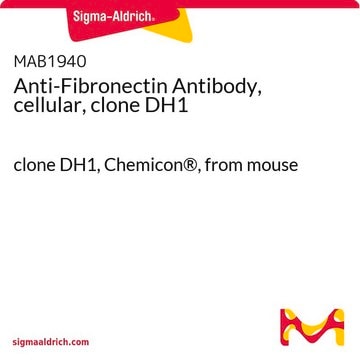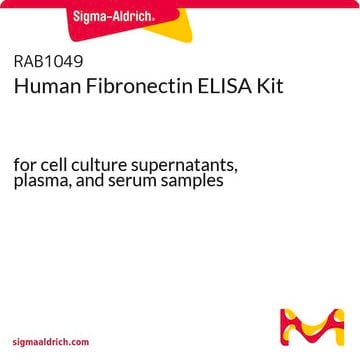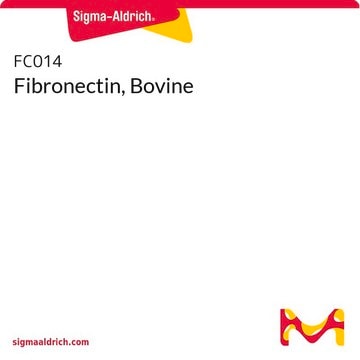F2518
Human Fibronectin
from human foreskin fibroblasts, powder, suitable for cell culture
Synonyme(s) :
Fibronectin
About This Item
Produits recommandés
product name
Fibronectine, lyophilized powder, suitable for cell culture
Source biologique
human foreskin fibroblasts
Niveau de qualité
Gamme de produits
BioReagent
Forme
lyophilized powder
Poids mol.
~550 kDa
Conditionnement
pkg of 0.5 mg
Technique(s)
cell culture | mammalian: suitable
Couverture de surface
1‑5 μg/cm2
Impuretés
Human Source, none detected (HCV)
Human Source, none detected (HIV)
Human Source, none detected (HTLV)
Human Source, none detected (HbSAg)
Microbial Contamination, passes test
Solubilité
H2O: 1 mg/mL at 37 °C (Store reconstituted solution in working aliquots at -20°C or lower.)
Numéro d'accès NCBI
Numéro d'accès UniProt
Spécificité de la liaison
Peptide Source: Collagen
Conditions d'expédition
dry ice
Température de stockage
−20°C
Informations sur le gène
human ... FN1(2335)
Vous recherchez des produits similaires ? Visite Guide de comparaison des produits
Catégories apparentées
Description générale
Application
Actions biochimiques/physiologiques
Caractéristiques et avantages
- Fibronectin is isolated from human foreskin fibroblasts maintained in serum-free medium.
- It can be used as a cell attachment factor for various cell types, including epithelial, mesenchymal, neuronal, neural crest, endothelial cells, and fibroblasts.
- The starting material is tested and found negative for HIV and HBsAg.
- The product is soluble in sterile water, yielding a clear, colorless solution.
- It can be stored at -20°C for at least three years.
Attention
Forme physique
Notes préparatoires
Reconstitution
Remarque sur l'analyse
Code de la classe de stockage
11 - Combustible Solids
Classe de danger pour l'eau (WGK)
WGK 3
Point d'éclair (°F)
Not applicable
Point d'éclair (°C)
Not applicable
Équipement de protection individuelle
Eyeshields, Gloves, type N95 (US)
Certificats d'analyse (COA)
Recherchez un Certificats d'analyse (COA) en saisissant le numéro de lot du produit. Les numéros de lot figurent sur l'étiquette du produit après les mots "Lot" ou "Batch".
Déjà en possession de ce produit ?
Retrouvez la documentation relative aux produits que vous avez récemment achetés dans la Bibliothèque de documents.
Les clients ont également consulté
Articles
Fibronectin (FN) plays crucial roles in extracellular matrix fibril assembly and cellular interactions.
Extracellular matrix proteins such as laminin, collagen, and fibronectin can be used as cell attachment substrates in cell culture.
Cancer stem cell media, spheroid plates and cancer stem cell markers to culture and characterize CSC populations.
Protocoles
Dilute fibronectin for cell attachment, varying per cell type. Coating protocol, products, and FAQs provided.
Diluer la fibronectine à la concentration souhaitée. Les conditions d'adhésion optimales dépendent du type de cellules et de l'application. La concentration de coating standard varie de 1 à 5 µg/cm2. Protocole de coating de fibronectine, produits et FAQ.
Notre équipe de scientifiques dispose d'une expérience dans tous les secteurs de la recherche, notamment en sciences de la vie, science des matériaux, synthèse chimique, chromatographie, analyse et dans de nombreux autres domaines..
Contacter notre Service technique









